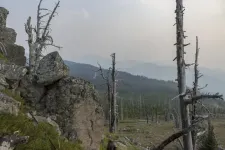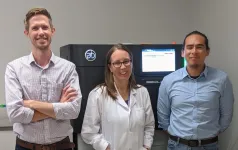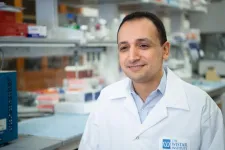Looking at tumors through a new lens
ISB-led study reveals vulnerabilities in recurrent glioblastoma, providing potential co-targets for enhancing neoadjuvant immune checkpoint blockade
2021-06-29
(Press-News.org) Neoadjuvant immune checkpoint blockade (ICB) is a promising treatment for melanoma and other cancer types, and has recently been shown to provide a modest survival benefit for patients with recurrent glioblastoma. To improve the treatment efficacy, researchers are looking for vulnerabilities in surgically removed glioblastoma tissues, but this has been difficult due to the vast differences within the tumor and between patients.
To address this challenge, researchers at Institute for Systems Biology (ISB) and their collaborators developed a new way to study tumors. The method builds mathematical models using machine learning-based image analysis and multiplex spatial protein profiling of microscopic compartments in the tumor.
The team used the approach to analyze and compare tumor tissues collected from 13 patients with recurrent glioblastoma and 23 patients with high-risk melanoma, with both sets of patients treated with neoadjuvant ICB. Using melanoma to guide the interpretation of glioblastoma analyses, they identified the proteins that correlate with tumor-killing T cells, tumor growth, and immune cell-cell interactions.
"This work reveals similarities shared between glioblastoma and melanoma, immunosuppressive factors that are unique to the glioblastoma microenvironment, and potential co-targets for enhancing the efficacy of neoadjuvant immune checkpoint blockade," said Dr. Yue Lu, co-lead author of the paper describing the research.
"This framework can be used to uncover pathophysiological and molecular features that determine the effectiveness of immunotherapies," added Dr. Alphonsus Ng, co-lead author of the paper.
The work was published today in Nature Communications, and is a collaborative project by ISB, UCLA and MD Anderson. Brain cancer represents one of the most challenging settings for achieving immunotherapy success. The fruitful collaboration between scientists and clinicians provides a tremendous opportunity for improving patient care and achieving an understanding of cancer immunotherapy at the deepest levels.
"We believe that the integrated biological, clinical and methodological insights derived from comparing two classes of tumors widely seen as at the opposite ends of the spectrum with respect to immunotherapy treatments should be of interest to broad scientific and clinical audiences," said ISB President Dr. Jim Heath, corresponding author of the paper.
INFORMATION:
About ISB
Institute for Systems Biology (ISB) is a collaborative and cross-disciplinary non-profit biomedical research organization based in Seattle. We focus on some of the most pressing issues in human health, including COVID, cancer, brain health, aging, and many chronic and infectious diseases. Our science is translational, and we champion sound research that results in real-world clinical impacts. ISB is an affiliate of Providence, one of the largest not-for-profit health care systems in the United States. Follow us online at http://www.isbscience.org, and on END
ELSE PRESS RELEASES FROM THIS DATE:
2021-06-29
Sophia Antipolis - 29 June 2021: Heart attacks during the COVID-19 pandemic were more likely to result in heart failure compared with heart attacks one year earlier, according to research presented today at Heart Failure 2021, an online scientific congress of the European Society of Cardiology (ESC).1
"Heart attack patients waited an average of 14 hours to get help during the pandemic, with some delaying for nearly two days. That compares to a delay of six hours in the previous year," said study author Dr. Ali Aldujeli of the Hospital of Lithuanian University of Health Sciences, Kaunas, Lithuania. "This gap may have been one contributor to the higher incidence of subsequent heart failure."
Urgent treatment for heart attacks is essential to restore the flow of oxygen-rich ...
2021-06-29
Scientists have for the first time detected black holes eating neutron stars, "like Pac Man", in a discovery documenting the collision of the two most extreme and enigmatic objects in the Universe.
The Laser Interferometer Gravitational-Wave Observatory (LIGO) in the US and the Virgo gravitational-wave observatory in Italy have captured the gravitational waves from the death spiral and merger of a neutron star with a black hole, not once but twice. The findings are published today.
The researchers say their observations will help unlock some of the most complex mysteries of the Universe, including the building blocks of matter and the workings of space and time.
More than 1,000 scientists were involved with the ...
2021-06-29
As smoky air becomes more common during Washington's wildfire season, many wildlife enthusiasts wonder: What happens to the birds?
Few studies have looked at wildfire smoke impacts on animals, let alone birds. And as Washington and the larger West Coast continue to experience more massive wildfires and smoke-filled air, understanding how birds are affected by smoke -- and how air pollution may influence our ability to detect birds -- are important factors for bird conservation.
Researchers from the University of Washington now provide a first look at the probability of observing common birds as air pollution worsens during wildfire seasons. They found that smoke affected the ability to detect more than a third of the bird species studied ...
2021-06-29
For the first time, researchers have confirmed the detection of a collision between a black hole and a neutron star. In fact, the scientists detected not one but two such events occurring just 10 days apart in January 2020. The extreme events made splashes in space that sent gravitational waves rippling across at least 900 million light-years to reach Earth. In each case, the neutron star was likely swallowed whole by its black hole partner.
Gravitational waves are disturbances in the curvature of space-time created by massive objects in motion. During the five years since the waves were first measured, a finding that led to the END ...
2021-06-29
A long time ago, in two galaxies about 900 million light-years away, two black holes each gobbled up their neutron star companions, triggering gravitational waves that finally hit Earth in January 2020.
Discovered by an international team of astrophysicists including Northwestern University researchers, two events -- detected just 10 days apart -- mark the first-ever detection of a black hole merging with a neutron star. The findings will enable researchers to draw the first conclusions about the origins of these rare binary systems and how often they merge.
"Gravitational ...
2021-06-29
Gravitational wave detectors have observed a new type of cataclysmic event in the cosmos: the merger of a neutron star with a black hole.
The phenomenon was detected twice in January 2020.
Several hypotheses could explain the existence of such mixed pairs. Further observations will be needed in order to settle the question.
Another missing piece has just been added to our knowledge of cosmic phenomena. The LIGO, Virgo and KAGRA collaborations have announced the first detection of gravitational waves (1) resulting from the 'mixed' merger between a black hole and a neutron star (2). The discovery, published on June 29, 2021 in Astrophysical Journal Letters, involves CNRS researchers working within ...
2021-06-29
LOUISVILLE, Ky. - Historically, most large-scale immunogenomic studies - those exploring the association between genes and disease - were conducted with a bias toward individuals of European ancestry. Corey T. Watson, Ph.D., assistant professor in the University of Louisville Department of Biochemistry and Molecular Genetics, is leading a call to actively diversify the genetic resources he and fellow immunogenomics researchers use in their work to advance genomic medicine more equitably.
Watson, along with UofL post-doctoral fellow Oscar Rodriguez, Ph.D., and visiting fellow Yana Safonova, Ph.D., are part of an international group of researchers ...
2021-06-29
PHILADELPHIA -- (June 29, 2021) -- New biomarkers that predict HIV remission after antiretroviral therapy (ART) interruption are critical for the development of new therapeutic strategies that can achieve infection control without ART, a condition defined as functional cure. These biomarkers can also provide critical clues into the biological mechanisms that control HIV replication after stopping therapy, and can help design novel strategies to cure HIV. Scientists at The Wistar Institute have identified metabolic and glycomic signatures in the blood of a rare population of HIV-infected individuals who can naturally sustain viral suppression after ART cessation, known as post-treatment controllers. These findings were published in Nature ...
2021-06-29
Scientists at the University of Sydney and Japan's National Institute for Material Science (NIMS) have discovered that an artificial network of nanowires can be tuned to respond in a brain-like way when electrically stimulated.
The international team, led by Joel Hochstetter with Professor Zdenka Kuncic and Professor Tomonobu Nakayama, found that by keeping the network of nanowires in a brain-like state "at the edge of chaos", it performed tasks at an optimal level.
This, they say, suggests the underlying nature of neural intelligence is physical, and their discovery opens an exciting avenue for the development of artificial intelligence.
The study is published today in Nature Communications.
"We used wires 10 micrometres long and no thicker than 500 nanometres ...
2021-06-29
Researchers from Queen Mary University of London have identified a protein that could be used to aid in the diagnosis of pancreatic cancer.
Findings from the new study suggest that a protein called pentraxin 3 (PTX3) may be a specific diagnostic biomarker - or biological measure - for pancreatic cancer, with the ability to differentiate pancreatic cancer from other non-cancerous conditions of the pancreas.
The research was published today in npj Precision Oncology, and primarily funded by the Pancreatic Cancer Research Fund, Barts Charity and Cancer Research UK.
PTX3 levels elevated in patients with pancreatic ...
LAST 30 PRESS RELEASES:
[Press-News.org] Looking at tumors through a new lens
ISB-led study reveals vulnerabilities in recurrent glioblastoma, providing potential co-targets for enhancing neoadjuvant immune checkpoint blockade





